Flesh on the bones of (nearly) all great gardens
IF shrubs and trees provide the backbone of a garden, then herbaceous perennials are the flesh that fills it out.
They're the plants that 'come back every year', but die down and become dormant in winter.
Although the epitome of the cottage garden border, their vast ranks supply plants that can fit into any style - courtyard, architectural, patio.
There's nothing so splendid as seeing a well-planned border blooming from June to October, wih ever-changing relationships of blooms, leaves and colour.
Plants are social beings
Unfortunately, there's also nothing so sad as seeing a single Rudbeckia struggling to make an impact on its own. These plants are social beings - plant them in odd numbers - a minimum of three in a small garden.
Only plant single specimens if they're absolute whoppers, like Gunnera (6ft wide leaves), Rodgersia or Rheum (ornamental rhubarb). Don't think herbaceous perennials are only there for their flowers - these three are grown for their spectacular foliage.
Some plants need staking, but I tend to get round that by planting things very close, or inserting twiggy branches around the new shoots in spring. The plants grow through them and they're unobtrusive. There are also good supports on the market - check out my useful links.
The Chelsea Chop
You may have heard of the 'Chelsea Chop' - cutting back growth by a half to a third around the last week in May (the time of RHS Chelsea Flower Show). It's an idea if you want bushier plants which are less prone to wind damage, but it will delay flowering.
Suitable plants include: Anthemis tinctoria, Echinacea, Helenium, Phlox paniculata, upright Sedums and Solidago.
The down side to such a blaze of glory is the dying down in autumn. Conventional wisdom told us to chop them down at the first frosts.
I'm glad things are changing, that some of us are leaving behind the skeletons of the plants to help the birds and overwintering insects, giving some structure to a bleak time of year.
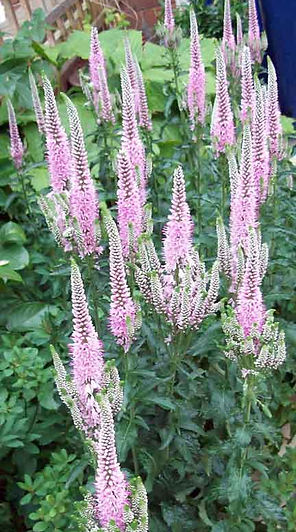


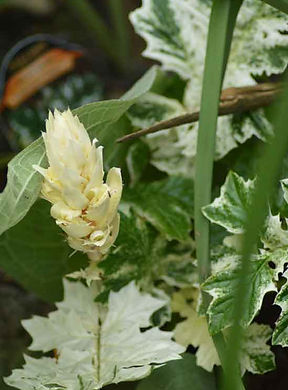

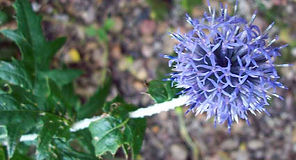

From top, Acanthus mollis Tasmanian Angel; Rheum palmatum with Heuchera Paprika; pond with Rodgersia, Alchemilla mollis, hosta and Heuchera Plum Pudding.
From top, Echinops (globe thistle); Veronica Atomic Silvery Pink Ray; Kniphofia uvaria Nobilis (red hot poker).

From top: RHS Plant of the Century Geranium Rozanne; raised bed with Veronica, Shasta daisies, Heuchera Silver Blush, golden hop; Ligularia The Rocket, bronze fennel and Lysimachia.

PERENNIAL plants for free - you can't get better than that! Most herbaceous perennials need to be divided every three years or so to keep flowering well - but you can divide more often if you want to propagate the plant.
It's best to dig up and divide summer-flowering plants in spring or autumn, avoiding frost and waterlogging. Spring-flowering plants, such as irises, are best divided in summer after flowering.
Using a fork, lift plants gently to limit root damage. Small, fibrous-rooted plants such as bugles, Heuchera and Epimedium can be pulled apart gently, producing small clumps for replanting.
Large, fibrous-rooted perennials, such as Hemerocallis (day lily), need two forks inserted into the crown back-to-back. Lever the roots into however many chunks you need.
I find an old pruning saw is very useful for this job, especially for plants with woody crowns or fleshy roots. Make sure each clump has three-five buds.
Crocosmia and Dierama are slightly different - their roots form chains of corms which are better kept intact, especially Dieramas, which don't like root disturbance and will sulk. If you have to divide, do it in spring and dig down 30cm (1ft) to avoid damage. Replant sections at their original depth. Bear in mind Crocosmia like to be crowded, so don't be too keen to divide them.
Hostas need to be divided before the buds burst. Plant divisions as soon as possible, feed and water them in well.
Suitable plants for division: Agapanthus, Anemone, Aster, Bergenia (elephant’s ears), Convallaria (lily-of-the-valley), Crocosmia, Dierama, Delphinium, Epimedium, Eryngium (sea holly), Euphorbia, Gentian, Geranium, Helianthus, Hemerocallis (day lily), Hosta, Iris, Lychnis, Lysichiton, Lysimachia, ornamental grasses, Primula (primrose) Ranunculus (buttercup), Salvia, Sedum, Verbena, Zantedeschia (arum lily).
Eryngium Blue Hobbit (sea holly).
Get plants for free!


Suitable for division: Crocosmia and Helianthus Lemon Queen.

HERE are my favourites. I buy plants as much for foliage as their flowers:
Heucheras and Heucherellas: ground huggers with vibrant foliage. Recommended are Plum Pudding (deep purple). Marmalade (golden pink upper leaves, purple underneath); Obsidian (almost black); Paprika (burnt orange) and Silver Blush (purple metallic veining).
Pulmonaria ocupol Opal (liverwort): a must for shade, with clusters of pale-blue flowers above small neat leaves spotted with silver.
Achillea mollis (lady's mantle): a prolific self-seeder with frothy lime flowers and handsome foliage.
Daisy family (Rudbeckia, Gaillardia, Echinacea, etc): they come in a wide variety of colours and are invaluable for late summer/autumn colour.
Cardoon (cynara) or globe artichokes: stately, architectural plants for the back of the border.
Kniphofia (red hot pokers): I like Ice Queen, dwarf, green-tipped buds opening palest creamy-yellow and Kniphofia uvaria Nobilis, fiery red, large flower spikes, 2m.
Lamprocapnos (Dicentra) spectabilis Alba, (white bleeding heart): dissected, fresh green leaves and perfect flower stems in late spring.
Echinops and Eryngium: The globe thistle and sea holly have architectural foliage and flowers, in shades of steely blue/grey and are loved by bees.
Bear's breeches (Acanthus mollis): glossy, lobed foliage and tall white/purple flower spikes, 1-1.5 metres. Tasmanian Angel has almost pure cream leaves and flower spikes with a pink tinge.
Yarrow (Achillea millefolium): many varieties, eg, Cloth of Gold grows to 1.8m, with large, flattened heads of bright yellow flowers. Summer Berries mix easy to grow from seed.
Hostas they get a section to themselves. (see link below).
Aquilegia (Granny's bonnet, Columbine): Blackcurrant Ice is deep purple/white, prolific self-seeder.
Helianthus (perennial sunflower) Lemon Queen: to 2m tall, with dark green foliage and light yellow flowers, late flowerer.
Bergenia (elephant's ears): An evergreen, Admiral has oval, upstanding, weather-resistant leaves, bright winter colour with bronze and crimson tints with cherry-pink flowers in spring.
The best perennials
Herbaceous perennials: border stalwarts
THE Hardy Plant Society (HPS) is an invaluable organisation for any gardener to seek advice from.
As its name suggests, members specialise in growing hardy herbaceous plants. The HPS runs plenty of activities and gives members the chance to meet other like-minded gardeners.
The society aims to: "inform and encourage the novice gardener, stimulate and enlighten the more knowledgeable, and entertain and enthuse all gardeners bonded by a love for, and an interest in, hardy perennial plants."
There are local and specialist groups throughout the country; for instance, the North East group has meetings running from September to May and talks cover a varied range of gardening and plant interest, at Stannington Village Hall, Near Morpeth, Northumberland NE61 6EL.
The HPS's website is a mine of information for all gardeners - I couldn't recommend it highly enough and they're a lovely bunch of people.
For more information on groups in your area, advice on plants, where to buy them, meetings or special events, log on to www.hardy-plant.org.uk.

Hardy Plant Society
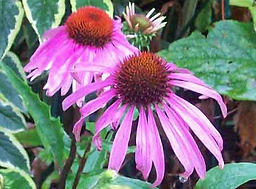
Late-season colour: Shasta daisy Aglaia, which flowered until November last year; Echinacea purpurea; globe artichoke.
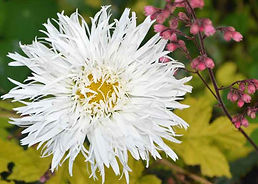
Globe artichoke in flower.


